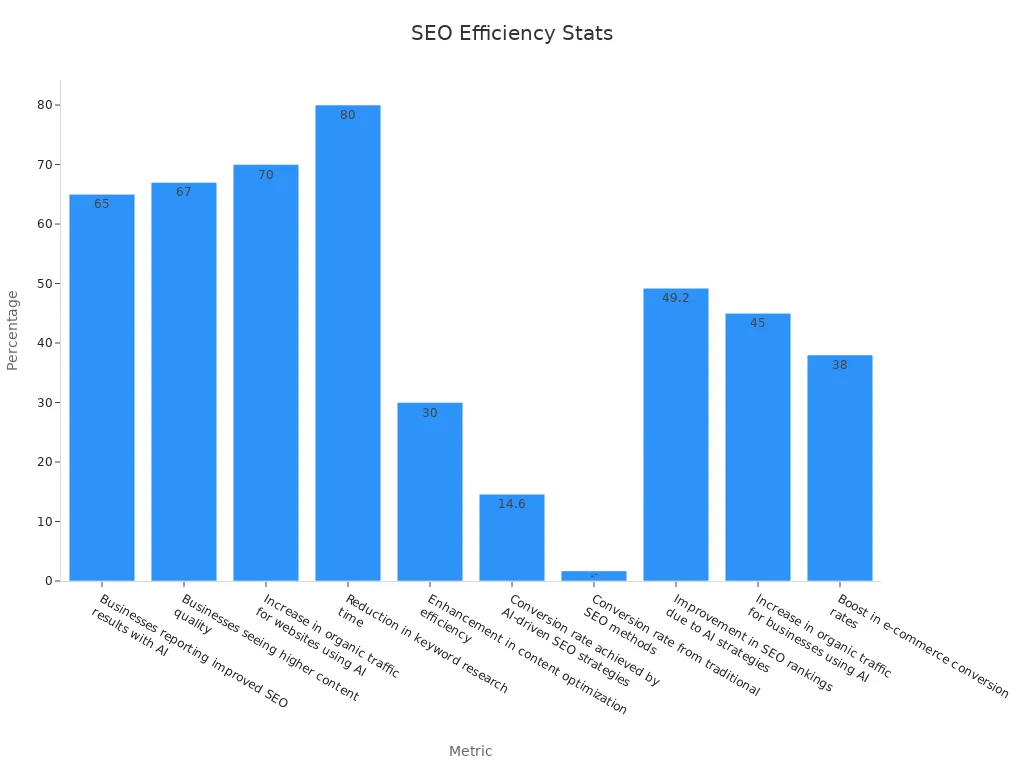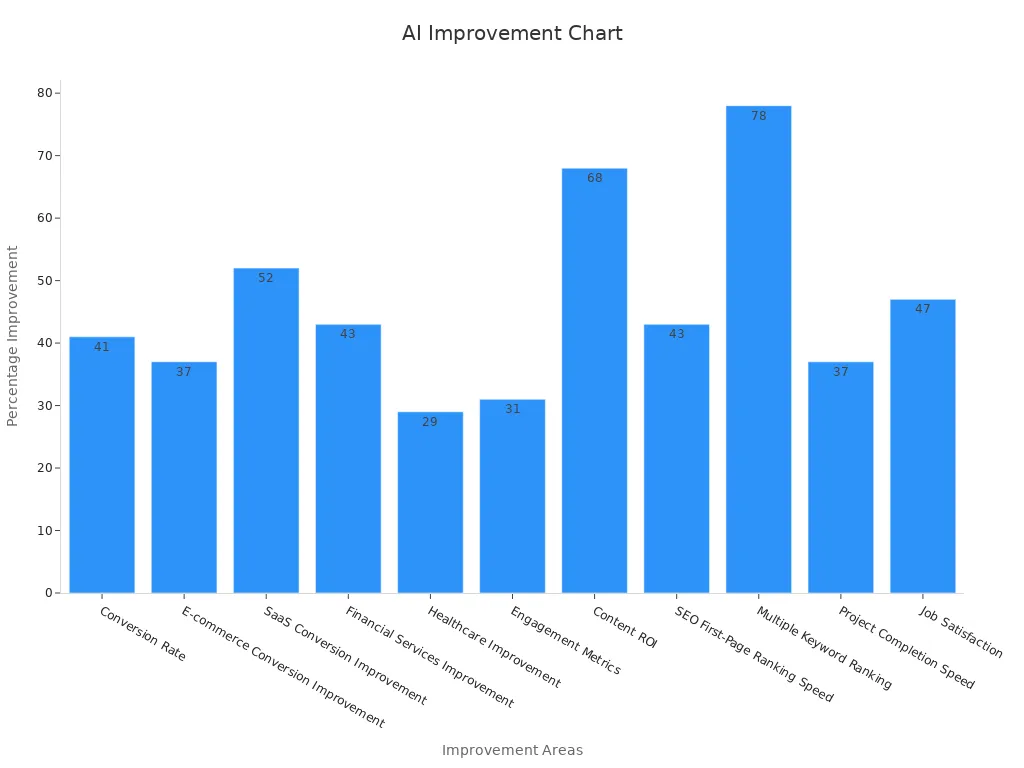
AI is reshaping how you approach Search Engine Optimization. It automates tedious tasks, like keyword research and meta-tag optimization, saving you time and effort. Did you know 86% of SEO professionals already use AI in their strategies, and 65% of businesses have seen better results because of it? By mastering AI-driven techniques, you’ll not only boost your rankings but also stay ahead in this competitive digital landscape. It’s time to adapt, innovate, and secure your place in search results.
Key Takeaways
-
AI tools can do boring SEO work for you. This saves time and makes your results better. Use these tools to work faster and smarter.
-
Voice search is important to focus on. Use longer keywords and answer clear questions to show up more in searches.
-
Organized data helps search engines understand your site. Add schema markup to make your site easier to find and get more clicks.
Understand AI Algorithms in Search Engine Optimization
Basics of AI in Search Engines
AI has transformed how search engines work, making them smarter and more efficient. Instead of just matching keywords, modern search engines use AI to understand the meaning behind your queries. This shift allows them to deliver more accurate and relevant results.
Different search engines rely on unique AI algorithms to enhance their performance. Here's a quick look at some of the key technologies:
|
Search Engine |
AI Algorithm/Technique |
Description |
|---|---|---|
|
OpenAI |
Vector Embeddings |
Converts user queries into vector embeddings for data retrieval. |
|
|
RankNet, LambdaRank |
Machine learning algorithms for ranking search results based on content quality. |
|
|
PaLM |
A model trained for improved reasoning and handling complex queries. |
|
Perplexity |
Dynamic LLM-Model |
Chooses the best model based on query complexity and domain. |
|
Custom AI |
RAG |
Combines LLMs with retrieval techniques for context-relevant responses. |
These algorithms help search engines process vast amounts of data, rank content effectively, and even predict what you’re looking for. By understanding these technologies, you can align your Search Engine Optimization strategies with how search engines operate.
Role of Machine Learning and NLP in SEO
Machine learning and natural language processing (NLP) are the backbone of AI-driven Search Engine Optimization. Machine learning analyzes massive datasets to identify patterns and trends. For example, it can predict which keywords will drive traffic based on historical data. This makes keyword research faster and more accurate.
NLP, on the other hand, focuses on understanding the context and intent behind search queries. It helps search engines interpret complex language and deliver results that match what users really want. Google’s BERT algorithm is a great example. It uses NLP to understand the nuances of human language, ensuring that your content ranks higher if it aligns with user intent.
By leveraging these technologies, you can create content that resonates with both search engines and users. This approach not only improves your rankings but also enhances the overall user experience.

Optimize for Voice Search and Conversational Queries
Importance of Long-Tail Keywords
Voice search is changing how people interact with search engines. Instead of typing short phrases, users now ask full questions like, “What’s the best pizza place near me?” This shift makes long-tail keywords essential for your Search Engine Optimization strategy. These keywords are longer and more specific, helping you match conversational queries more effectively.
Why should you care about long-tail keywords? Here’s what market research reveals:
-
By 2024, nearly 50% of all searches will be voice-based.
-
Over 1 billion voice searches happen every month.
-
75% of households will own smart speakers by 2025.
These trends show that optimizing for voice search isn’t optional—it’s a necessity. Long-tail keywords also improve your chances of appearing in featured snippets and “People Also Ask” sections, boosting your visibility. Start by researching common questions your audience asks and incorporate those phrases naturally into your content.
Tip: Use tools like AnswerThePublic or Google’s “People Also Ask” feature to discover popular conversational queries.
Creating Content for Specific Questions
When users perform voice searches, they often look for direct answers to specific questions. Your content should address these questions clearly and concisely. For example, if someone asks, “How do I bake a chocolate cake?” your article should provide step-by-step instructions, along with tips for success.
Creating content that answers specific questions has several benefits:
-
It helps you understand your audience’s needs and pain points.
-
It enhances engagement by addressing topics that resonate with your readers.
-
It increases your chances of appearing in featured snippets, zero-click searches, and local packs.
|
Metric |
Description |
|---|---|
|
Featured Snippets |
Direct answers displayed at the top of search results, enhancing visibility. |
|
People Also Ask (PAA) |
A section that suggests related queries, increasing user engagement and visibility. |
|
Zero-Click Searches |
Users receive answers without clicking through, indicating high visibility of the content. |
|
Local Packs |
Displays localized search results, crucial for local businesses to attract foot traffic. |
To create effective content, focus on originality, accuracy, and timeliness. Research your audience thoroughly to understand their questions and craft content that provides value. This approach not only improves your rankings but also builds trust with your readers.
Leverage Structured Data for Better Search Visibility

Using Schema Markup Effectively
Structured data is like giving search engines a cheat sheet about your content. By using schema markup, you help search engines understand your website better, which can lead to improved visibility. Think of it as adding labels to your content so search engines know exactly what it’s about.
Here’s how structured data works:
|
Description |
|
|---|---|
|
Improved entity recognition |
Helps search engines accurately identify and categorize entities. |
|
Context provision |
Adds context to your content, making it easier for search engines to determine relevance. |
|
Integration with knowledge graphs |
Connects your information to established knowledge bases for better visibility. |
|
Rich results |
Displays visually appealing formats that grab user attention. |
|
Knowledge panels |
Highlights essential information directly in search results, boosting trust and engagement. |
For example, adding schema markup for products, events, or articles can make your content stand out. An e-commerce site that implemented product schema saw a 30% increase in click-through rates and a 20% rise in sales. Similarly, local businesses using local schema experienced a 40% jump in reservations.
Tip: Use tools like Google’s Structured Data Markup Helper to simplify the process of adding schema to your site.
Enhancing Click-Through Rates with Rich Snippets
Rich snippets are the eye-catching elements in search results that make users want to click. They include things like star ratings, images, and FAQs. By implementing structured data, you can create these snippets and boost your click-through rates.
Here’s why rich snippets work:
-
They occupy more space in search results, making your content more visible.
-
They match user queries better, increasing the likelihood of clicks.
-
Pages with rich snippets often see higher engagement and organic traffic.
Case studies show the power of rich snippets:
-
SAP experienced a 400% growth in clicks from rich results.
-
Sharp Healthcare achieved an 843% increase in clicks within nine months.
-
Rotten Tomatoes saw a 25% higher click-through rate thanks to rich snippets.
Adding schema markup for recipes, videos, or events can also enhance your results. For instance, recipe schema improves engagement by displaying cooking times and ingredients directly in search results. Video schema adds thumbnails, making your content more clickable.
Note: Regularly test and update your schema markup to ensure it aligns with evolving search engine requirements.
Create AI-Friendly Content
Aligning Content with AI Search Intent
Creating content that aligns with AI search intent is all about understanding what users truly want. AI doesn’t just look at keywords anymore. It dives deeper, analyzing user behavior to uncover the “why” behind every search. For example, when someone searches for “best laptops for students,” AI determines they’re likely looking for affordable, lightweight options with good battery life.
To align your content with these expectations, focus on relevance and value. AI tools can help you identify emerging keywords and cluster them by topic. This ensures your content covers all aspects of a subject, making it more comprehensive and authoritative.
|
Insight |
Description |
|---|---|
|
Keyword Research |
|
|
User Intent Understanding |
AI analyzes user behavior to match content with real needs. |
|
Content Optimization |
AI clusters keywords to create well-rounded, high-ranking content. |
AI can streamline this process by automatically clustering keywords based on their relevance and search intent, which helps in creating comprehensive content that covers all aspects of a topic.
When you tailor your content to solve specific problems, you not only improve your rankings but also build trust with your audience. A skincare brand, for instance, optimized its product descriptions and got featured in AI-generated recommendations, boosting both visibility and conversions.
Using AI Tools for Content Optimization
AI tools are game-changers for content optimization. They analyze top-performing pages, flag gaps in your content, and suggest improvements. Whether it’s refining your headlines or enhancing readability, these tools ensure your content meets both user and search engine expectations.
Studies show that AI-optimized content delivers impressive results. Campaigns using AI tools see a 41% higher conversion rate, while SEO-first page rankings happen 43% faster. Here’s a breakdown of how AI tools improve performance:
|
Improvement Area |
Statistic |
|---|---|
|
Conversion Rate |
41% higher for AI-optimized campaigns compared to traditional campaigns |
|
Engagement Metrics |
AI content generates 31% higher engagement metrics |
|
SEO First-Page Ranking Speed |
43% faster for AI-optimized content |
|
Multiple Keyword Ranking |
78% more likely for AI-optimized content |

By leveraging these tools, you can create content that resonates with your audience and ranks higher in search results. AI tools also save time, allowing you to focus on strategy rather than manual tasks. This is how you future-proof your Search Engine Optimization efforts.
Enhance Website Performance and User Experience

Improving Page Speed and Mobile Responsiveness
Your website’s performance plays a huge role in keeping visitors engaged. A slow-loading page can frustrate users and drive them away. In fact, websites with slow loading times lose over half their visitors, which hurts both traffic and conversions. To avoid this, focus on improving your page speed. Faster websites not only enhance user experience but also rank higher in search results.
Mobile responsiveness is equally important. With more people browsing on their phones, your site must adapt to different screen sizes. A good mobile experience isn’t just about speed. It’s also about usability. Make sure buttons are easy to tap, and layouts are clear. Responsive design ensures your site looks great and works well on any device. This encourages users to stay longer and engage more with your content.
Here are some key performance benchmarks to track:
|
Metric |
Description |
|---|---|
|
Page Load Time |
The total time taken for a web page to fully load. |
|
First Contentful Paint (FCP) |
Measures the time until the first piece of content is displayed on the user's screen. |
|
Time to First Byte (TTFB) |
The duration for a user's browser to receive the first byte of data from the server. |
|
Largest Contentful Paint (LCP) |
The time taken for the largest piece of content to load, impacting user perception of speed. |
|
First Input Delay (FID) |
The time taken for a web page to respond to a user interaction, such as clicking a button. |
Focusing on Core Web Vitals and Accessibility
Core web vitals are essential metrics that measure how users experience your site. They include things like loading speed, interactivity, and visual stability. Improving these metrics can boost your search rankings and make your site more user-friendly. For example, users who experience load times of three seconds or less visit 60% more pages. On the other hand, pages that take longer than three seconds lose 50% of their visitors.
Accessibility is another critical factor. It ensures everyone, including those with disabilities, can navigate your site. Features like alt text for images, keyboard navigation, and readable fonts make a big difference. When you prioritize accessibility, you not only comply with regulations but also create a better experience for all users.
In competitive niches, where many sites are optimized, core web vitals and accessibility can set you apart. They show search engines that your site delivers value, which can improve your rankings and drive more traffic. By focusing on these areas, you future-proof your Search Engine Optimization strategy and create a site that users love.
Utilize AI-Powered Tools for Search Engine Optimization
Tools for Keyword Research and Content Analysis
AI-powered tools have revolutionized how you approach keyword research and content analysis. Instead of spending hours manually identifying keywords, you can now rely on platforms like SEMrush and SurferSEO to do the heavy lifting. These tools analyze massive datasets to uncover high-value keywords and provide actionable insights for optimizing your content.
Here’s a quick look at how these tools can boost your Search Engine Optimization efforts:
|
Tool |
Functionality Description |
Impact on SEO Performance |
|---|---|---|
|
Optimize webpages to gain prominent spots on search engine results pages. |
Improves ranking factors like backlinks and keywords. |
|
|
SEMrush |
Conducts keyword research to identify high-value keywords. |
Drives traffic and improves search rankings. |
|
SurferSEO |
Analyzes top-ranking pages and provides content optimization recommendations. |
Ensures content aligns with search engine algorithms. |
By leveraging these tools, you can create content that not only ranks higher but also resonates with your audience. Platforms like MarketMuse even help you identify content gaps, ensuring your website stays ahead of the competition.
Tip: Use AI tools to cluster keywords by topic. This helps you cover all aspects of a subject, making your content more comprehensive and authoritative.
Automating SEO Tasks with AI Platforms
AI platforms take the hassle out of repetitive SEO tasks. From automating meta-tag generation to scheduling content updates, these tools save you time and effort. They also provide valuable insights into audience behavior, helping you refine your strategy.
Statistics show just how effective AI can be:
-
65% achieve better SEO results after implementing AI tools.
-
40% of marketers see a 6-10% revenue increase thanks to AI.
With tools like chatbots, you can even enhance lead generation and audience engagement. For example, 26% of B2B marketers saw a 10-20% increase in leads by using AI-powered chatbots. These platforms don’t just automate tasks—they also provide insights that help you make smarter decisions.
Note: Regularly review your AI tools to ensure they align with your evolving SEO goals.
Monitor and Adapt to AI Trends
Tracking AI-Driven Metrics
To stay ahead in the ever-changing world of Search Engine Optimization, you need to track AI-driven metrics. These metrics help you measure the effectiveness of your strategies and identify areas for improvement. Start by recording your current performance. This includes tracking organic traffic, conversion rates, and keyword rankings. Once you have a baseline, set specific goals. For example, aim for a 20% increase in organic traffic or better rankings for targeted keywords.
Regular monitoring is key. Use analytics dashboards to visualize changes over time. A/B testing can also help you compare strategies with and without AI insights. This way, you’ll know what works best. Finally, create a feedback loop. Use the data you gather to refine your AI tools and strategies.
Here’s a quick breakdown of how to track these metrics effectively:
|
Performance Metric |
Description |
|---|---|
|
Baseline Measurement |
Record current SEO performance metrics for comparison, including organic traffic and conversion rates. |
|
Set Specific Goals |
Define success metrics, such as a 20% increase in organic traffic or improved keyword rankings. |
|
Regular Monitoring and Reporting |
Use analytics dashboards to visualize performance changes over time. |
|
A/B Testing |
Compare effectiveness of strategies with and without AI insights. |
|
Feedback Loop |
Refine AI tools and strategies based on insights gained from monitoring. |
By keeping an eye on these metrics, you’ll make smarter decisions and stay ahead of the competition.
Staying Updated on Algorithm Changes
Search engines constantly update their algorithms, and these changes can significantly impact your website’s performance. For instance, Google’s March 2025 Core Update caused major shifts in rankings for many websites. Staying informed about such updates is crucial. They can affect your organic visibility, traffic, and overall strategy.
Here’s why staying updated matters:
-
Algorithm updates often lead to fluctuations in rankings and traffic.
-
Timely adaptations can help you maintain or improve your position in search results.
-
Quality content remains a top priority, as updates frequently reassess how content is ranked.
To stay ahead, follow trusted SEO blogs, attend webinars, and subscribe to industry newsletters. These resources will keep you informed about the latest trends and changes. When you adapt quickly, you’ll ensure your strategies remain effective in the evolving landscape of Search Engine Optimization.
Mastering AI-driven Search Engine Optimization isn’t just about staying competitive—it’s about thriving in a digital-first world. By applying these seven strategies, you can boost rankings, improve visibility, and future-proof your efforts. Success stories like Bankrate’s 125,000 monthly organic visits or Rocky Brands’ 30% revenue growth show what’s possible when you embrace AI tools. Keep learning, adapting, and refining your approach. The future of SEO is here, and it’s yours to conquer.
FAQ
What is AI SEO, and why does it matter?
AI SEO uses artificial intelligence to optimize your website for search engines. It matters because it improves rankings, saves time, and helps you stay competitive in a digital-first world.
How can I start optimizing for voice search?
Focus on long-tail keywords and conversational phrases. Answer specific questions your audience asks. Tools like AnswerThePublic can help you find relevant queries.
Are AI tools expensive for SEO beginners?
Not always! Many AI tools offer free or affordable plans. Start with tools like Google Analytics or Ubersuggest to explore AI-driven insights without breaking the bank.
